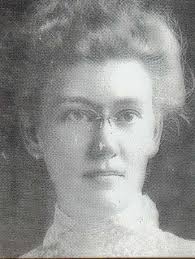Edith Mansford Fitzgerald
| Edith Mansfield Fitzgerald | |
|---|---|
 Edith Mansfield Fitzgerald | |
| Born |
1877 Memphis, Tennessee |
| Died | June 26, 1940 |
| Nationality | American |
| Other names | Edith Fitzgerald |
| Occupation | teacher, inventor |
| Years active | 1904–1938 |
| Known for | Fitzgerald Key |
Edith Mansfield Fitzgerald (1877–1940) was a deaf American woman who invented a system for the deaf to learn proper placement of words in the construction of sentences. Her method, which was known as the 'Fitzgerald Key,' was used to teach those with hearing disabilities in three-quarters of the schools in the United States.
Biography
Edith Mansfield Fitzgerald was born in 1877[1] in Memphis, Tennessee.[2] After attending public schools, she believed that her disability stunted her learning process. At these schools, she was taught through the method of lip reading.[3] Later on, she enrolled in the Illinois School for the Deaf in Jacksonville, Illinois. After graduating, she then attended Gallaudet University in Washington, D.C.[4] completing her B.A.[5] in 1903 and graduated as valedictorian of her class.[6]
Career
Fitzgerald began teaching soon after her graduation and taught in regular sessions and also trained teachers at Training Colleges over the summers.[4] She served at the Wisconsin School for the Deaf in Delavan, Wisconsin for 17 years[2] and then, in 1921, taught at the Louisiana School for the Deaf. The following year, she moved to the Arkansas School for the Deaf and, in 1924, was made assistant principal at the Virginia School for the Deaf and the Blind in Staunton, Virginia.[5] While she was teaching in Virginia, Fitzgerald developed a system of teaching which became known as the "Fitzgerald Key". The program taught students to write linear sentences which were grammatically correct. By following the placement of subject, verb, object, and adjectival phrase in a specific order, students learned to construct sentences which were easily understood in their language.[7] During the summer sessions, she taught at normal schools in Kansas, Milwaukee and Virginia and in the summer of 1930, she taught in the summer faculty at Johns Hopkins University.[4] In 1933, Fitzgerald moved to the Georgia School for the Deaf in Cave Spring and the following year took a post at the Texas School for the Deaf in Austin, where she remained for three years. She worked in Oak Park, Illinois in 1937,[5] where the National Fraternal Society for the Deaf was located.[8] That same year, she spoke at the Biennial Meeting of the Convention of American Instructors of the Deaf and completed a study course at Columbia University.[9] Fitzgerald returned to Cave Spring, Georgia in 1938, and died 2 years later on 26 June 1940.[5]
Legacy
Fitzgerald's seminal work 'Straight Language for the Deaf: A System of Instruction for Deaf Children' was published in 1926 and was widely influential in the field of deaf education.[10] Because the "Fitzgerald Key" gave additional visual support to those who had not heard language construction,[11] it allowed students to correct their own grammar and syntax mistakes.[12] At one time, her system was so widely used that three-quarters of the schools in the United States teaching those with hearing difficulties used it.[2][13] Her book had been through nine editions by 1962.[14]
Selected works
- Fitzgerald, Edith Mansford. Signs and pure oralism. Washington, D.C.: National Association of the Deaf.
- Kennard, Marie Sewell; Fitzgerald, Edith Mansford (1939). Suggestions for mental development. Cave Springs, Georgia: Georgia School for the Deaf.
- Kennard, Marie Sewell; Fitzgerald, Edith Mansford (1939). Straight language discusses arithmetic. Cave Springs, Georgia: Georgia School for the Deaf.
- Kennard, Marie Sewell; Fitzgerald, Edith Mansford (1941). Nature study. Cave Springs, Georgia: Georgia School for the Deaf.
- Fitzgerald, Edith Mansford (1962). Straight Language for the Deaf: A System of Instruction for Deaf Children (9th ed.). Washington, D.C.: Volta Bureau.
References
- ↑ Simpson 1963.
- 1 2 3 Hurwitz, Vicki T. (2007). "Late-Deafened Women Who Beat the Odds: If Only I Knew!" (PDF). Rochester, New York: Association of Late-Deafened Adults, Inc. p. 7. Retrieved 21 December 2015.
- ↑ "Education of the Deaf". Oshkosh Daily Northwestern. Oshkosh, Wisconsin. 29 December 1905. p. 7. Retrieved 21 December 2015 – via Newspapers.com.

- 1 2 3 "Edith Fitzgerald Well Known Deaf Teacher in City". The Jacksonville Daily Journal. Jacksonville, Illinois. 11 October 1931. p. 17. Retrieved 21 December 2015 – via Newspapers.com.

- 1 2 3 4 "Edith Mansford Fitzgerald : B.A., 1903". Washington, DC: Gallaudet University Alumni Cards, 1866–1964. 26 June 1940. Retrieved 21 December 2015.
- ↑ Carroll & Fischer 2001, p. 49.
- ↑ Carroll & Fischer 2001, p. 50.
- ↑ Hull & West 1931, p. 2.
- ↑ "New York". Deaf-Mutes' Journal. New York City, New York: New York School for the Deaf. 66 (26): 1. 1 July 1937. Retrieved 22 December 2015.
- ↑ Panara, Robert F. (1970). "The Deaf Writer in America from Colonial Times to 1970, Part ii" (PDF). Rochester, New York: Rochester Institute of Technology Digital Media Library. p. 2. Retrieved 22 December 2015.
- ↑ Glennen & DeCoste 1997, p. 142.
- ↑ Nicolosi, Harryman & Kresheck 2004, p. 129.
- ↑ Nasukiewicz, Jennifer (Fall 1998). "Deaf Inventors" (PDF). Washington, DC: Gallaudet University. p. 6. Retrieved 21 December 2015.
- ↑ Fitzgerald 1962.
Bibliography
- Carroll, Cathryn; Fischer, Catherine Hoffpauir (2001). Orchid of the Bayou: A Deaf Woman Faces Blindness. Washington, DC: Gallaudet University Press. ISBN 978-1-56368-104-2.
- Glennen, Sharon; DeCoste, Denise C. (1997). The Handbook of Augmentative and Alternative Communication. San Diego, California: Cengage Learning. ISBN 1-56593-684-1.
- Hull, Callie; West, Clarence (1931). Reprint and Circular Series of the National Research Council. Washington, DC: National Academies. NAP:12027.
- Nicolosi, Lucille; Harryman, Elizabeth; Kresheck, Janet (2004). Terminology of Communication Disorders: Speech-language-hearing (5th ed.). Philadelphia, Pennsylvania: Lippincott Williams & Wilkins. ISBN 978-0-7817-4196-5.
- Simpson, William M (1963). Edith Fitzgerald, 1877–1940: Originator of the Straight Language System. Washington, D.C.: Gallaudet College.